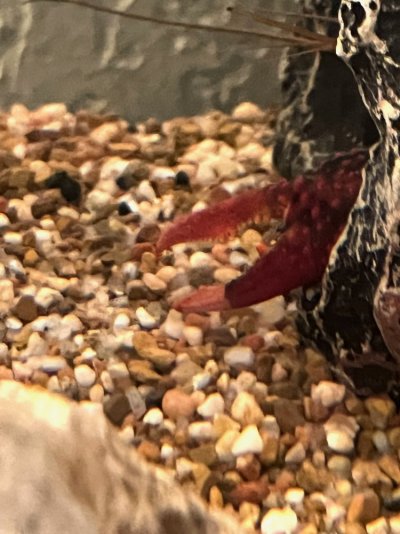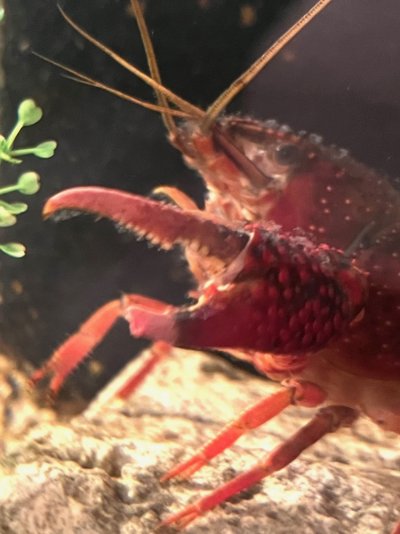Hi and welcome to the forum

Freshwater crayfish can get fungal or bacterial infections in the shell and it can cause the shell to break off. The infection usually spreads over a period of months and eventually kills the animal. Fungal infections in the shell are more common than bacterial.
The crayfish might have broken its claw when it grabbed something and got it caught, subsequently snapping off part of the claw.
The main thing now is to prevent infection in the damaged shell and underlying muscle tissue. A clean tank will help with this and you can add some salt to help as well. Most medications for fish will kill crustaceans and the only medication I use on crustaceans (besides salt) is Sulpha based medications like Triple Sulpha (Tri Sulfa). I would try using salt first and see how it goes.
--------------------
Wipe the inside of the glass down with a clean fish sponge. This removes the biofilm on the glass and the biofilm will contain lots of harmful bacteria, fungus, protozoans and various other microscopic life forms.
Do a 75% water change and gravel clean the substrate every day for a week. The water changes and gravel cleaning will reduce the number of disease organisms in the water and provide a cleaner environment for the fish to recover in. It also removes a lot of the gunk and this means any medication can work on treating the fish instead of being wasted killing the pathogens in the gunk.
Make sure any new water is free of chlorine/ chloramine before it is added to the tank.
Clean the filter if it hasn't been done in the last 2 weeks. However, if the filter is less than 6 weeks old, do not clean it. Wash the filter materials/ media in a bucket of tank water and re-use the media. Tip the bucket of dirty water on the garden/ lawn. Cleaning the filter means less gunk and cleaner water with fewer pathogens so any medication (if needed) will work more effectively on the fish.
Increase surface turbulence/ aeration to maximise the dissolved oxygen in the water.
Add some salt, (see directions below).
--------------------
SALT
You can add rock salt (often sold as aquarium salt), swimming pool salt, or any non iodised salt (sodium chloride) to the aquarium at the dose rate of 2 heaped tablespoon per 20 litres (5 gallons) of water.
Keep the salt level like this for at least 2 weeks.
The salt will not affect the beneficial filter bacteria, fish, plants, shrimp or snails.
After you use salt and the fish/ crustacean have recovered, you do a 10% water change each day for a week using only fresh water that has been dechlorinated. Then do a 20% water change each day for a week. Then you can do bigger water changes after that. This dilutes the salt out of the tank slowly so it doesn't harm the fish.
If you do water changes while using salt, you need to treat the new water with salt before adding it to the tank. This will keep the salt level stable in the tank and minimise stress on the fish.
When you first add salt, add the salt to a small bucket of tank water and dissolve the salt. Then slowly pour the salt water into the tank near the filter outlet. Add the salt over a couple of minutes.


